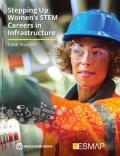With a focus on wastewater, this publication presents a range of solutions to reduce plastic and microplastic pollution from the source to the sea. It also encourages policymakers and practitioners to set priorities and select those that are more cost-effective and suitable for their local context. Finally, it stresses the importance of having technical solutions in addition to appropriate legislation, economic instruments, education, and awareness that force real change on the ground.

For a few weeks in March and April 2020, the COVID-19 lockdown brought about an unexpected side effect: dramatically cleaner air and endless vistas unlike anything cities have experienced in living memory. As 2020 progressed, the pandemic, the economic downturn, and a growing reckoning with racial injustice in the United States converged to place economic, social, and public health strains on local governments. Efforts are now underway by these governments to help their communities recover. As they do so, there is an opportunity to implement local changes that can deliver multiple community benefits while also helping to accelerate recoveries. There is an opportunity to build back better.
Air quality and equity are highly interconnected issues. And there are actions cities can take to help address them both simultaneously.

This report describes a variety of ways to level the pathway for women entering into and progressing in science, technology, engineering, and mathematics (STEM) employment within the infrastructure sectors—energy and extractives; water; transport; and digital development.
Volume 1 distills the findings from an extensive literature review, a global stocktaking exercise, key informant interviews, and five case studies in order to provide World Bank Group project teams with insights that they can use to support women’s STEM careers in infrastructure at each stage of their careers—from initial attraction to the sectors and job recruitment, to retention within organizations, and advancement to managerial and leadership roles.

This report synthesises multiyear, multidisciplinary climate change studies on the Sundarbans—the world’s largest remaining contiguous mangrove forest and wetland of international importance, as well as home to some of South Asia’s poorest and most vulnerable communities. The studies’ findings indicate that, in a changing climate, sea-level rise, storm-surge intensification, and water salinization will alter the Sundarbans ecosystem significantly.
Agriculture and food systems in the LAC region are among the most successful on the planet, but the impressive achievements have come at the expense of significant environmental and health costs. The region’s successes in feeding the population and exporting food to the rest of the world are exacting high costs on people and on the environment.
